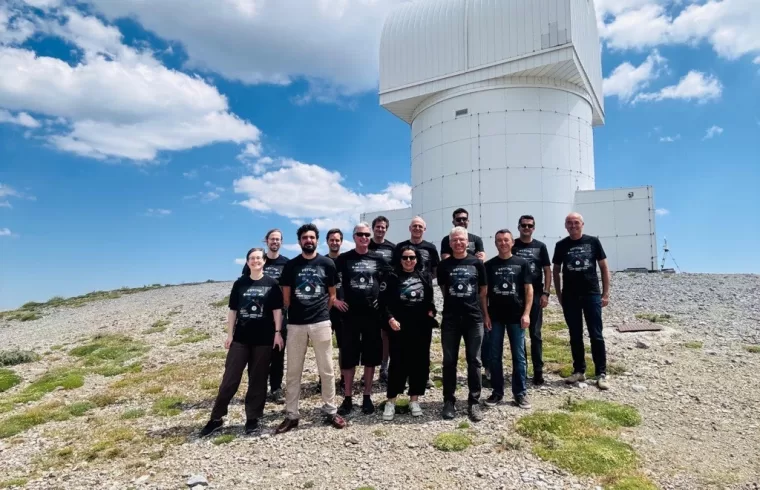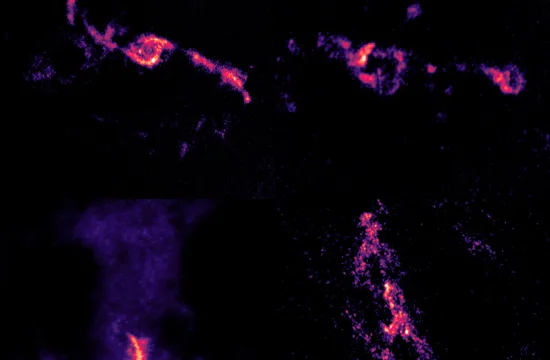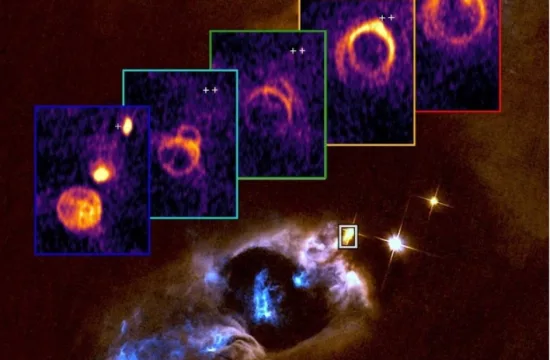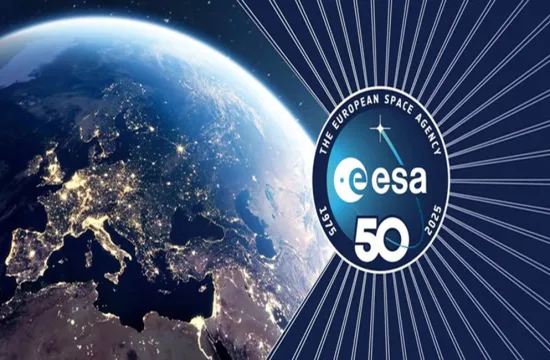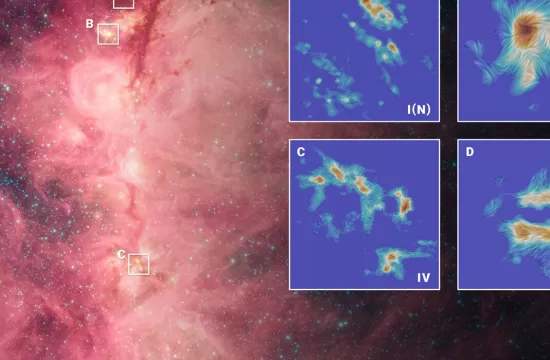
The European Space Agency (ESA) successfully established a transmission-reception optical link with NASA’s Deep Space Optical Communications (DSOC) experiment onboard its Psyche mission, located 265 million kilometers away.
On 7 July 2025, ESA marked a historic milestone by establishing the first-ever optical communication link between a European ground segment and a spacecraft in deep space. The link was made with the transmitting and receiving optical ground stations in Greece to NASA’s Psyche mission and its Deep Space Optical Communications (DSOC) experiment onboard, currently at a distance of 1.8 astronomical units, around 265 million km.
This is the first of four planned links this summer.
This achievement marks yet another milestone in the long history of cross-support between space agencies, demonstrating the potential for interoperability between ESA and NASA in the realm of optical communications, something previously only achieved with radiofrequency systems.
“The first successful demonstration of deep-space optical communication with a European ground segment marks a leap towards bringing terrestrial internet-like high-speed connectivity to our deep-space spacecraft. This joint achievement, together with our colleagues and partners in industry and academia, ESA’s Directorate of Technology, and NASA/JPL, underlines the importance of international cooperation,” says Rolf Densing, ESA’s Director of Operations.
“This is an amazing success. Through years of technological advancements, international standardization efforts, and adoption of innovative engineering solutions, we have set a cornerstone of the Solar System Internet,” says Mariella Spada, ESA’s Head of Ground Systems Engineering and Innovation.
Establishing a laser link across the solar system
The transmission campaign begins in Greece, where ESA has transformed two observatories into high-precision optical ground stations.
From the Kryoneri Observatory, located near Athens, a powerful laser beacon is directed toward NASA’s Psyche spacecraft. Though it carries no data, the beacon is designed to be so precisely targeted that the DSOC experiment onboard Psyche can lock onto it and send a return signal back to Earth. That return signal is then captured by the Helmos Observatory, situated 37 km away on a neighboring mountain peak.
“This two-way optical handshake meant overcoming two major technical challenges: developing a laser powerful enough to hit a distant spacecraft with pinpoint accuracy and building a receiver sensitive enough to detect the faintest return signal, sometimes just a few photons, after a journey of hundreds of millions of kilometers,” explains Sinda Mejri, project manager of the ESA’s Ground Laser Receiver system.
To achieve this level of precision, ESA’s flight dynamics experts at the ESA’s Space Operations Centre (ESOC) calculated the spacecraft’s trajectory and accounted for variables such as air density, temperature gradients, and planetary motion. This process is similar to the ones used in global navigation satellite systems, but with the added complexity of deep-space distances and the need for ultra-accurate pointing.
Meanwhile, mission controllers at NASA’s Jet Propulsion Laboratory (JPL) provided Psyche’s position using Delta-DOR, a powerful navigation technique that enables millimeter-level accuracy and is also employed by ESA for interplanetary missions.
To ensure safety during the laser transmissions, sections of Greek airspace were temporarily closed.
Years of preparation, installed within days
The success of the link was the result of years of preparation and collaboration. Two optical ground stations had to be built.
The Ground Laser Transmitter integrates five high-power lasers with ultra-precise steering controllers into a special 20-foot-long container with a lifting platform. This allowed the sensitive equipment to be protected from sunlight during the day and lifted into the open after sunset.
Meanwhile, the Ground Laser Receiver takes the form of a sophisticated receiver unit known as an ‘optical bench.’ This single-photon sensitive receiver unit will be securely mounted to the rear of the 2.3 m Aristarchos telescope, located at 2340 m.
In April, the team ran a rehearsal campaign by beaming a single low-power signal to ESA’s Alphasat satellite. Located in geostationary orbit, at 36,000 km altitude, the satellite is a prime test bed for optical communications technologies, thanks to a bespoke terminal provided by Germany’s DLR.
“Despite the complexity of the task, the final installation of the lasers, electrical wiring, and cooling systems was successfully completed shortly after their delivery the same morning,” said Clemens Heese, ESA’s deep-space optical communication project manager. “Achieving ‘laser installation and safe laser emission on the sky within a day’ is a remarkable testament to the team’s precision, coordination, and dedication.”
Moments later, the final dry runs allowed the team to review full procedure walkthroughs and perform a live laser test to optimize timing and coordination.
The effort involved fewer than 20 people on-site: 7 at Kryoneri, 12 at Helmos, and a support team in the United States operating the spacecraft. NASA’s Jet Propulsion Laboratory also sent two experts to assist.
A glimpse into the future
This demonstration is more than a technical feat. It’s a glimpse into the future of deep space communication.
Establishing a laser link from Earth to a spacecraft at distances of 1.5 to 2 astronomical units demands exceptional precision, advanced engineering, and seamless coordination. The successful connection with Psyche and the DSOC payload on 7 July 2025 proves that this challenge can be met. Europe has shown it is ready to play a key role in the future of high-capacity optical communications in deep space,” said Andrea Di Mira, project manager of ESA’s Ground Laser Transmitter system at ESOC.
Optical links promise data rates 10 to 100 times higher than current radiofrequency systems. Combining this technology with the ones we have for radiofrequency communications is essential to transmit the ever-increasing data output of the missions exploring the universe.
“We’re proud to have ESA featured on the Deep Space Optical Communications (DSOC) experiment onboard our Psyche mission. It’s a powerful example of what international cooperation can achieve, and a glimpse into the future of communications in deep space,” says Abi Biswas, project technologist for DSOC at NASA JPL.
The success also lays the groundwork for ESA’s proposed ASSIGN (Advancing Solar System Internet and GrouNd) program, to be presented at the ESA Council Meeting at Ministerial Level (CM25) in November.
“ASSIGN will aim at federating existing and future radiofrequency and optical networks into a secure and resilient interoperable network of networks for ESA’s missions as well as institutional and commercial ones, and fostering European industry competitiveness for its realization and future exploitation,” says Mehran Sarkarati, ESA’s Head of Ground Stations Engineering Division and Program Manager for ASSIGN Program.
Industrial and international collaboration
ESA’s participation in the DSOC demonstration is made possible by a consortium of European companies, including QTLabs (AT), Single Quantum (NL), GA Synopta (CH), QSSys (DE), Safran Data Systems (FR), and NKT Photonics Ltd (UK), and by the National Observatory of Athens (GR), which allowed them to turn its Helmos and Kryoneri observatories into deep-space optical ground stations and provided critical infrastructure.
The project is funded through ESA’s General Support Technology Programme and Technology Development Element.
Looking ahead, ESA is currently studying a Mars electric propulsive tug capability, called ‘LightShip,’ which would transport passenger spacecraft to Mars. Following passenger drop-off, LightShip would transfer to a service orbit where it would provide communications and navigation services through the MARs Communication and Navigation Infrastructure (MARCONI) payload, part of which will include an optical communications demonstrator as part of the roadmap towards supporting future human missions.

